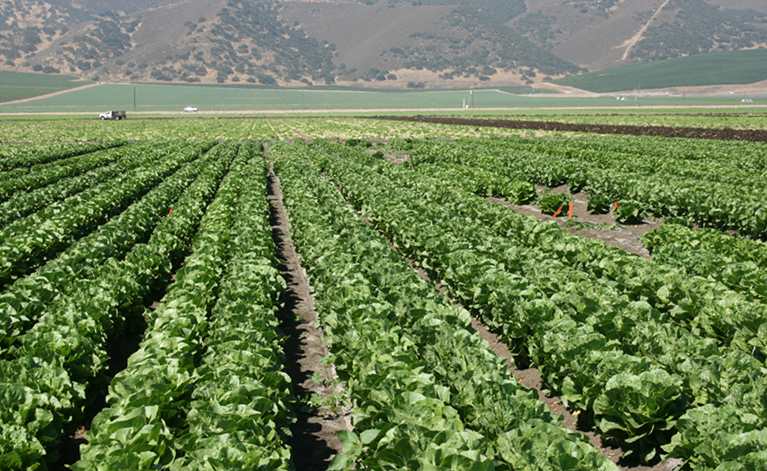Fusarium wilt-resistant lettuce aim of breeding trial

Salinas Valley farmers are on guard against a new variant of the soil-borne fungal disease Fusarium wilt in lettuce. An ongoing trial aims to find genetic sources of resistance to the new strain.
Photo/Bob Johnson


Photo/Bob Johnson
By Bob Johnson
Researchers say an unfolding trial may offer hope that lettuce varieties can soon be bred with resistance to a new variant of Fusarium wilt, which has recently appeared in farm fields in the Central Coast region.
At a field belonging to vegetable producer D’Arrigo California, a study team is evaluating lettuce resistance to a new strain of Fusarium known as CR4. Researchers say the results so far are promising.
Fusarium wilt, largely resulting from soil-borne pathogens, can cause lettuce plants to stunt and fail to form heads or result in seedlings wilting and dying. The disease can be particularly severe in lettuce plants suffering from water stress.
Researchers say grounds of the study field near Soledad are infested with the new variant and the more commonly found Fusarium race 1 strain. Yet they say they have been impressed with how certain lettuce plants are holding up, with many showing no signs of infection. Researchers noted that romaine varieties have been the least prone to infection.
The study group is monitoring the resistance of lettuce strains planted with seeds from different seed producers in an infected corner of the D’Arrigo field.
“Some of these plants look pretty good. It looks like there’s some potential for resistant varieties,” said Alex Putnam, a University of California Cooperative Extension plant pathology specialist based in Riverside.
The Soledad trial is part of an ongoing effort to discover genetic sources of resistance to the new Fusarium variant that has been detected in the Santa Maria and Salinas areas. Putnam offered overview of the research during an Aug. 5 field day for growers and pest control advisors.
If farmers have a susceptible lettuce variety planted in infested ground, they may be in for a tough time. Once a plant is infected with Fusarium wilt, there are no chemical controls to help it recover.
In California, Fusarium wilt occurs in lettuce in Fresno County and in the southern region of coastal Monterey County, according to UC pest management guidelines.
Fusarium wilt affects a wide range of crops, including vegetables, fruits and ornamentals. Symptoms include leaf yellowing and wilting and stunted growth. Infected plants eventually die. The pathogen can also be sustained on the roots of many plants.
Until recently, Fusarium race 1 was the only variant in California. The appearance of the new CR4 variant has made varieties previously resistant to Fusarium race 1 susceptible to the disease.
The trial of potential sources of resistance to the new variant was supported by D’Arrigo California, the California Department of Food and Agriculture and the Salinas-based California Leafy Greens Research Board.
Once an area of a field is infested with Fusarium wilt, it will remain viable and ready to infect lettuce indefinitely.
Farmers are instructed to take care to not spread the pathogen to other areas of the field on equipment or boots.
Before replanting lettuce, they are advised to wait for seed companies to offer varieties with resistance to the variant.
The new CR4 variant, which overcomes resistance to race 1, is now a focus of concern in the Central Coast region.
“CR4 is the new fusarium in Salinas and Santa Maria,” Putnam said.
Farm advisors say there are resistant varieties available to plant in areas that do not have the new variant.
“Growers around Watsonville should have enough resistant varieties to plant,” said Yu-Chen Wang, UCCE plant pathology farm advisor based in Watsonville.
Generally, romaine lettuce holds up better than iceberg against all known variants of fusarium wilt, Wang said.
In the Soledad trial, iceberg varieties Tombstone, Rhodenas and Tamarack all suffered 90% mortality, and most of the Yucaipa, Telluride, Oso Flaco and Primo plants also died, researchers reported.
There were 22 iceberg varieties with mortality below 50% in this year’s trial. Varieties that had mortality below 5% included Balboa, Fontina, San Andreas, Paraiso, Powerball, San Miguel and Meridian.
Among the Romaine lettuces, there were 21 varieties with marketable yields of 90% or more.
“There were more susceptible varieties last year,” Putnam said of the continuing research. “But I think the seed companies removed those this year.”
Fusarium wilt is a warm-weather disease that causes the plants to wilt and die as the season grows hotter.
It started in the warmer growing regions of Yuma and the Central Valley and later spread to the Central Coast region.
Because the pathogen can survive in the soil indefinitely, the main management strategies are to move lettuce crops to clean ground or plant resistant varieties.
(Bob Johnson is a reporter in Monterey County. He may be contacted at bjohn11135@gmail.com.)




